On this week's NewsFlash, we hear how antibodies from long term HIV patients could provide clues for new vaccine development. Plus, how farmers became our founding fathers, using Google pagerank for conservation priorities and strong, reliable, steel velcro. Plus, we look back on this Week in Science History and the invention of DNA fingerprinting.
In this episode
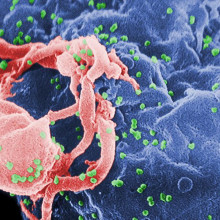
Novel HIV Vaccine Target Discovered
US Scientists working on HIV have uncovered a viral Achilles heel that might aid in the develop of a vaccine.
Writing in Science, Scripps Institute researcher Dennis Burton and his colleagues have been combing through more than 1800 blood samples from patients in Australia, Africa, Asia, Europe and the US looking for signs of antibodies, termed broadly neutralising antibodies, that can inactivate HIV.
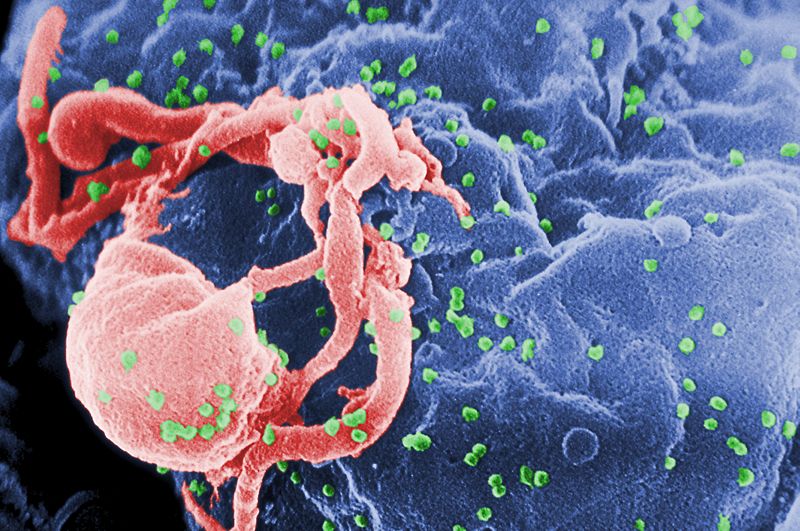 'By first finding antibodies that can inactivate HIV, we can then work out which part of the virus they're targeting and then use that very component as a vaccine,' Burton explains.
'By first finding antibodies that can inactivate HIV, we can then work out which part of the virus they're targeting and then use that very component as a vaccine,' Burton explains.
Previous attempts to carry out this line of investigation have yielded only antibodies that target relatively inaccessible components of the virus, making it very difficult to incorporate them into a vaccine. But now, with new technology and an updated approach, the team have immediately struck gold with their first patient and uncovered two new antibodies, dubbed PG9 and PG16, which can block the virus from invading and infecting cells.
By making mutant viruses with slightly differing surface structures and testing the newly-discovred antibodies against them, the team have also worked out that PG9 and PG16 target the spike proteins (gp120 and gp41) that decorate the surfaces of HIV particles. The virus uses these spikes like molecular velcro to enable it to recognise and infect immune cells, a process that the antibodies can disrupt.
'Critically,' says Burton, 'the region recognised by these new antibodies is potentially a much more accessible site for vaccine design.' But if people who are infected with HIV are alreading making these antibodies, why are they still carrying the disease?
'Preventing infection in the first place is a very different challenge than ridding the body of established HIV, which integrates itself into the human host's DNA, making it much harder for the immune system to detect. The fact that patients can make these sorts of antibodies - and we got this result from just the first patient we studied - is really encouraging because it suggests that a vaccine should be able to do the same.
So, in someone who is not infected, these sorts of antibodies [produced by a vaccine] should be protective.' The next step will be for the team to continue to use their 'brute force' screening-based approach, now that they know it works, to track down more neutralising antibodies, and the viral sites they recognise, to produce a vaccine that can protect against the widest range of HIV strains.
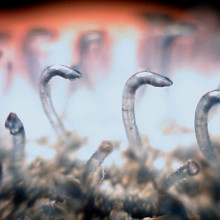
Steel Velcro
Velcro - or hook loop fasteners, are increadibly useful things. They were inspired by a natural means of distributing seeds such as burrs and have been used for uses varying from holding pockets closed to stopping things floating away in space. However velcro is normally made of plastic so is of limited use in hot conditions, and it has a limited strength.
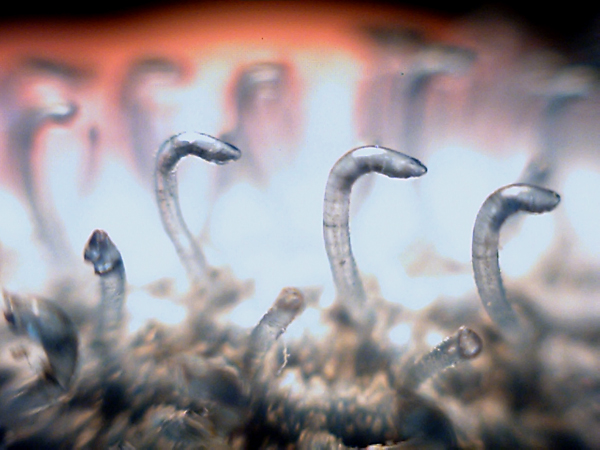 A group lead by Josef Mair at the Technical University in Munich has developed something rather tougher, steel velcro. Using 0.2mm steel sheets and a carefully designed process of pressing and bending, they've formed something which works just like velcro.
A group lead by Josef Mair at the Technical University in Munich has developed something rather tougher, steel velcro. Using 0.2mm steel sheets and a carefully designed process of pressing and bending, they've formed something which works just like velcro.
They have a couple of versions - one called Flamingo, which involves holes in one half and sprung prongs on the other half. You push the prongs through the holes and they lock together. They also have the more traditional Entenkopf (duck head) which has groups of steel loops close to each other on one side and barbed prongs on the other, which will catch on the loops.
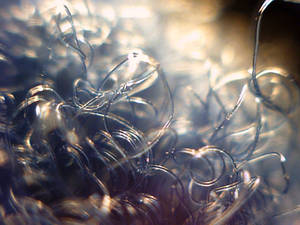 The velcro can carry up to 7 tonnes per square metre if the weight is pulling the sheets apart and up to 35 tonnes per square metre if it pulls along its length, so it's strong stuff. The real advantage is that it will maintain this hold at temperatures up to 800C so it could be used in assembling cars and other machines more quickly and easily.
The velcro can carry up to 7 tonnes per square metre if the weight is pulling the sheets apart and up to 35 tonnes per square metre if it pulls along its length, so it's strong stuff. The real advantage is that it will maintain this hold at temperatures up to 800C so it could be used in assembling cars and other machines more quickly and easily.
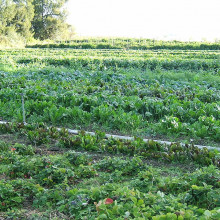
Where did all the farmers come from?
Farming and cities seem very much the norm now but in the grand scheme they're actually very recent developments. Modern humans have been around for about 200,000 years and farming has only been with us for the last ten thousand. Farming is a key threshold in human development because once you start farming a piece of land you can support a much greater number of people in a certain area than you would with most hunting and gathering. Although, there are some places in the world where land and sea are so abundant in food you don't need to farm to support lots of people (but that's another story...).
 The Near East (that includes Iraq, Iran and Syria) is one place where farming is thought to have originated and later spread through Europe. And there's been something of an argument between academics as to how the spread took place and how it happened so quickly. Some people have argued that farming techniques were rather peacefully communicated through neighbouring populations and that hunter-gatherers gradually gave up their lifestyle and language in favour of the farmers'. But some people argue that the farmers were a specific group of people who out-competed and eventually replaced the native hunter-gatherers in Europe.
The Near East (that includes Iraq, Iran and Syria) is one place where farming is thought to have originated and later spread through Europe. And there's been something of an argument between academics as to how the spread took place and how it happened so quickly. Some people have argued that farming techniques were rather peacefully communicated through neighbouring populations and that hunter-gatherers gradually gave up their lifestyle and language in favour of the farmers'. But some people argue that the farmers were a specific group of people who out-competed and eventually replaced the native hunter-gatherers in Europe.
Now Barbara Bramanti and her team have taken mitchondrial DNA (mtDNA) samples from three groups. Publishing in the journal Science this week,they took mtDNA from a group of 11,000 year-old hunter-gatherers and mtDNA from some of the earliest farmers. What they found was that these two groups were too distinct to be related. So they then looked at how ancient hunter-gatherers might be related to modern-day Europeans and again, the relationship was almost non-existent.
But it does seem that Central Europeans are descended, at least in part, from these early farmers. So what we can draw from this is that at the end of the last ice age, some people developed farming and they moved most the way across Europe, quite likely displacing the hunter-gatherers. And they think these farmers originated in an area around modern day Slovakia or Hungary but the researchers say they need to do a few more DNA studies to be sure.
So understanding when and why we started farming can tell us something about how we came to live in the cities we do today and also how farming might affect communities across the world which do practise hunter-gatherer lifestyles, e.g. the San in Namibia or Aeta in the Philippines.
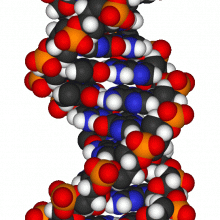
Electricians shocked to find out how DNA repairs itself
Scientists in America have shown that cells send electrical signals along their DNA to check its integrity.
If mutations or damage to DNA goes uncorrected, especially if it affects certain critical genes, the results can be disasterous for the viability of cells or whole organisms since one consequence of DNA damage is cancer. Thankfully cells are equipped with enzymes that can recognise genetic spelling mistakes made by mutations and can excise the incorrect letter and replace it with the right one.
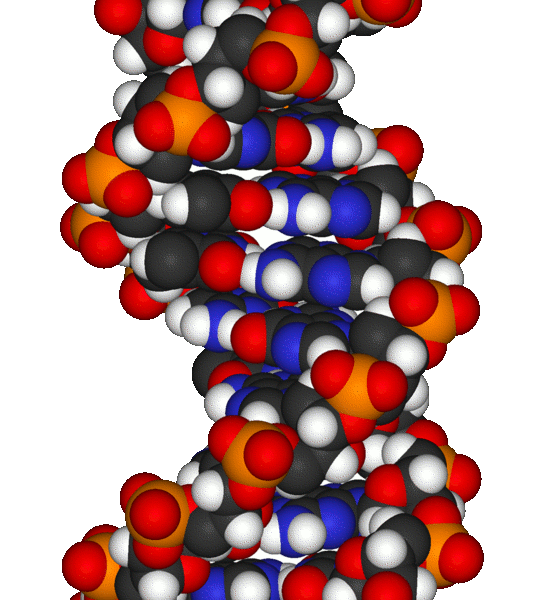 But a key question is how this checking process can take place quickly enough, given that the average human cell contains more than 3 billion genetic letters - that's more than a pile of encylopaedias piled taller than a person. To find out, Caltech scientist Jacky Barton and her colleagues used E. coli bacteria to study the process.
But a key question is how this checking process can take place quickly enough, given that the average human cell contains more than 3 billion genetic letters - that's more than a pile of encylopaedias piled taller than a person. To find out, Caltech scientist Jacky Barton and her colleagues used E. coli bacteria to study the process.
E. coli double their numbers every 20 minutes so they also need rapid mechanisms to check their DNA sequence and they also contain the bacterial equivalents of many of the same DNA repair enzymes used in humans, making them ideal study subjects. The researchers focused on two enzymes in particular MutY and EndoIII, which are charged with identifying specific types of DNA damage. These proteins can walk along a DNA chain, checking the sequence, but there aren't very many of them (there may be only 30 MutY proteins in an entire cell) and they move much too slowly to completely screen the genome within the time that they do. But what the researchers also noticed is that these proteins carry with them clusters of iron and sulphur atoms (4Fe-4S), which can pick up and release electrons, changing their charge in the process.
Now, in an elegant series of experiments in which the team made specific molecular tweaks to the structures of some of these repair enzymes, the researchers have shown that the repair enzymes work in pairs and signal to each other using the DNA between them like a telephone line. The process is incredibly simple: one repair protein lands on the DNA and activates itself. A second repair protein lands further along the DNA chain and releases a small amount of electric charge, which is conveyed along the DNA chain as if it were a wire. If it reaches the first protein this indicates that the DNA region separating the two proteins is intact and the sequence is correct. The first protein picks up the electrical charge and detaches from the DNA before binding somewhere else.
But if the sequence is wrong, as a consequence of mutation or damage for example, the signal does not transmit and the two proteins remain attached to the DNA and work their way slowly towards each other, laboriously checking each genetic letter as they go. When a fault is discovered and repaired, signalling between the two proteins is restored and they can depart to screen other parts of the genome. In this way, using electrical signalling, the entire genome can be checked and maintained in tiptop condition by using just a small number of repair enzymes.

Pagerank for Species
Most conservation effort seems to be put into species which are pretty or otherwise attractive to humans, but often there is no point in trying to conserve them if their ecosystem collapses. For example there is no point in stopping anyone killing pandas if the bamboo they live on dies out. In simple cases this result is obvious but in most ecosystems a species depends on, and is dependent upon, many other species. This makes it very hard to predict the knock on effects of loosing a species, without using huge complex computer models.
 According to Stefano Allesina and collegues Google's pagerank might hold the answer. This is the ranking system that Google uses to help decide which order to return search results. Basically if a site has lots of other sites linking to it, especially if they are important, then it is probably important too and should appear at the top of the list.
According to Stefano Allesina and collegues Google's pagerank might hold the answer. This is the ranking system that Google uses to help decide which order to return search results. Basically if a site has lots of other sites linking to it, especially if they are important, then it is probably important too and should appear at the top of the list.
Stefano has been applying this to food webs, so if lions, hyenas, leopards etc all eat a type of gazelle, they will all transfer some of their importance to the gazelle, depending on how much of their diet is gazelle. The gazelle, in turn, transfers importance to the grasses which it eats.
They then used these relationships to rank the species by how much damage they would do if they went extinct, and compared it to other much more complex mathematical models, and found that the results were the same. The Page Rank system is obviously scalable to immensely complex systems - it works for the web, so Stefano's system should work on a food web as complex as they come in the real world, and help conservationists concentrate on the most important species to protect.

18:07 - This Week in Science History - The Invention of DNA fingerprinting
This Week in Science History - The Invention of DNA fingerprinting
Sarah Castor-Perry
This week in science history saw, in 1984, the invention of DNA fingerprinting by Sir Alec Jeffreys. Since then, the technique has been used in thousands of paternity and criminal cases around the world.
Jeffreys had been working at the University of Leicester for seven years when he made his discovery. We know that variation in features such as eye colour and blood group are heritable, i.e. are passed on from parents to children and are easy to test for. Jeffreys and his team were interested in whether small changes in the DNA code itself could be found, as being able to detect these tiny changes and whether they are inherited could be used to tell people apart or tell if they were related.
Looking at something like the gene for blood group, you would not necessarily be able to say if two people were related or if two blood samples came from the same person, as there is so little variation - just A, AB, B and O - meaning that lots of people in the world have each blood type. In order to tell people apart using their DNA, the team began looking for pieces of DNA that would show more variation.
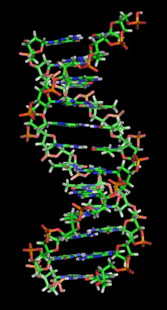 This led them to pieces called VNTRs - variable number tandem repeats, basically pieces of DNA that have repeats of a sequence of bases. There are four bases - adenine, thymine, cytosine and guanine (or A, T, C and G) that make up the genetic code. The order they are found in the DNA determines whether you have blonde hair, brown eyes or diseases such as cystic fibrosis. In a variable number tandem repeat area of DNA, there would be a 'core sequence' of between 10-80 bases, that would be repeated anywhere between one and twenty times in that piece of DNA, with the number of repeats being inherited from your parents. These repeats occur in many places in the human genome. The first variable number tandem repeat that Jeffreys and his team found was in the gene for myoglobin, an oxygen carrying pigment found in muscle. They were able to create a 'probe' for the core sequence, which could find the sequence anywhere that it was present in the DNA code.
This led them to pieces called VNTRs - variable number tandem repeats, basically pieces of DNA that have repeats of a sequence of bases. There are four bases - adenine, thymine, cytosine and guanine (or A, T, C and G) that make up the genetic code. The order they are found in the DNA determines whether you have blonde hair, brown eyes or diseases such as cystic fibrosis. In a variable number tandem repeat area of DNA, there would be a 'core sequence' of between 10-80 bases, that would be repeated anywhere between one and twenty times in that piece of DNA, with the number of repeats being inherited from your parents. These repeats occur in many places in the human genome. The first variable number tandem repeat that Jeffreys and his team found was in the gene for myoglobin, an oxygen carrying pigment found in muscle. They were able to create a 'probe' for the core sequence, which could find the sequence anywhere that it was present in the DNA code.
The 'eureka' moment occurred at 5 past 9 in the morning on September the 10th 1984. Jeffreys was looking at the results of an experiment they had carried out using the DNA of his lab assistant and her parents, to see if the probe they had created would show up inherited variations in the length of the sequence repeats. A clear pattern was visible, showing the differences in the lengths of the repeats between the assistant and her parents, but also which of the repeats she had inherited from each parent. Jeffreys immediately understood the importance of this technique for resolving paternity disputes, immigration cases and criminal cases.
Since the late 1990s, sequences of DNA called short tandem repeats, similar to the variable number tandem repeats discovered by Jeffreys, have been used. As the name suggests, short tandem repeats contain a much smaller 'core sequence' of between two and 10 bases, compared with between 10 and 80 for the variable number tandem repeats. These are less damaged by degradation of a DNA sample than the larger variable number tandem repeats, making them much more useful in a forensic case, where DNA from a crime scene might have been affected by time or the elements.
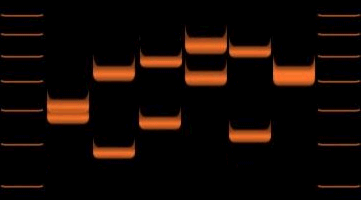 This is how DNA fingerprinting is carried out today. The DNA from a sample such as a mouth swab, blood sample or swab from a crime scene is extracted and purified. In order to isolate the short tandem repeats, a procedure called PCR is carried out on the DNA. PCR chops out and replicates specific parts of the DNA - in this case the short tandem repeats, amplifying the amount of these parts in the sample. The DNA will then be run on an agarose gel to separate out the different sized short tandem repeats using the fact that DNA is charged and will move through the gel when an electric current is passed across it. A long repeat where the core sequence is repeated say one hundred times will pass through the gel more slowly than a smaller repeat as the piece of DNA chopped out and replicated will be larger. It's a bit like if you have a tank full of golden syrup and drop two balls of equal weight but different size into it - the bigger ball will take longer to reach the bottom of the tank. If you took a photo after 10 seconds, the bigger ball would be higher up in the tank than the small one. If you kept running a gel, then all of the DNA would move through it to the other side, pulled by the electric current. But if you stop the electric current after a given time, the DNA will stop moving and will be separated out by size. In order for us to see the positions of the short tandem repeats in the gel, a dye must be used. This can either be added to the sample before it is run through the gel, or washed over it to pick out the short tandem repeat pieces after the gel has been run. When the pieces of DNA are shown up by the dye, they appear as distinct bands on the gel. It is the pattern of bands, showing the presence of different sized repeats that is analysed to show if a sample has come from a particular person.
This is how DNA fingerprinting is carried out today. The DNA from a sample such as a mouth swab, blood sample or swab from a crime scene is extracted and purified. In order to isolate the short tandem repeats, a procedure called PCR is carried out on the DNA. PCR chops out and replicates specific parts of the DNA - in this case the short tandem repeats, amplifying the amount of these parts in the sample. The DNA will then be run on an agarose gel to separate out the different sized short tandem repeats using the fact that DNA is charged and will move through the gel when an electric current is passed across it. A long repeat where the core sequence is repeated say one hundred times will pass through the gel more slowly than a smaller repeat as the piece of DNA chopped out and replicated will be larger. It's a bit like if you have a tank full of golden syrup and drop two balls of equal weight but different size into it - the bigger ball will take longer to reach the bottom of the tank. If you took a photo after 10 seconds, the bigger ball would be higher up in the tank than the small one. If you kept running a gel, then all of the DNA would move through it to the other side, pulled by the electric current. But if you stop the electric current after a given time, the DNA will stop moving and will be separated out by size. In order for us to see the positions of the short tandem repeats in the gel, a dye must be used. This can either be added to the sample before it is run through the gel, or washed over it to pick out the short tandem repeat pieces after the gel has been run. When the pieces of DNA are shown up by the dye, they appear as distinct bands on the gel. It is the pattern of bands, showing the presence of different sized repeats that is analysed to show if a sample has come from a particular person.
As TV shows like CSI and Silent Witness have shown, DNA fingerprinting is used in criminal cases to link suspects to a scene or to a rape victim, or to find the identity of a body, but a relatively new use of the technology is for conservation. It is being used at Zurich zoo to investigate how the flock of rare Ibis birds there are related, so that they can prevent the birds from inbreeding, something that is damaging to the health of the species.
There are some concerns about the use of DNA profiles, particularly with regard to DNA databases. In the UK, currently the police can hold DNA information of people who were arrested but not charged, raising concerns about civil liberties. Alec Jeffreys himself believes that although a DNA database is in theory a good idea for person or body identification in emergencies or after disasters like the 2004 Indian Ocean tsunami or 9/11, they should not be held by police.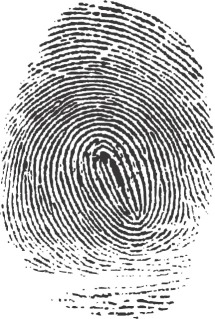
Countless criminal and paternity cases have involved DNA fingerprinting over the last twenty five years. It has allowed dangerous and violent criminals to be put away. There are occasional problems, particularly as such care must be taken to prevent contamination, but it is an essential tool in the fight against crime, and growing in use for conservation of rare species.
Related Content
- Previous Do Plants have Immunity?
- Next Can you run faster on the moon?









Comments
Add a comment